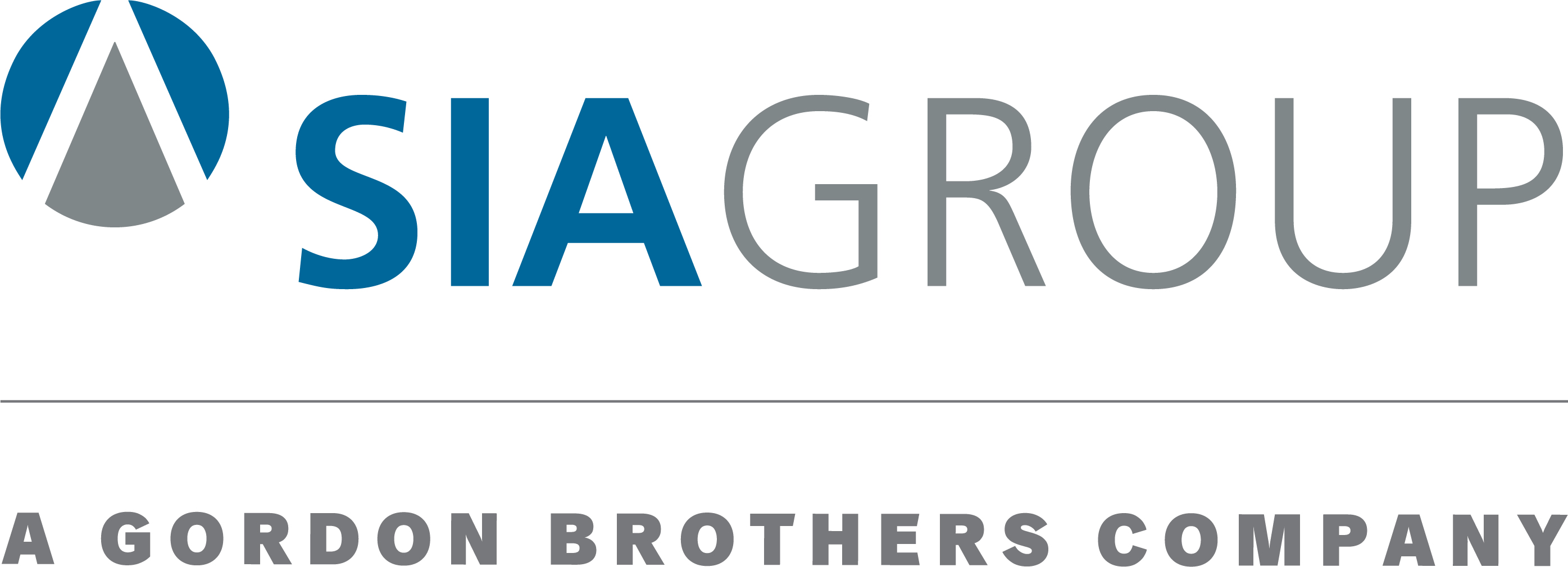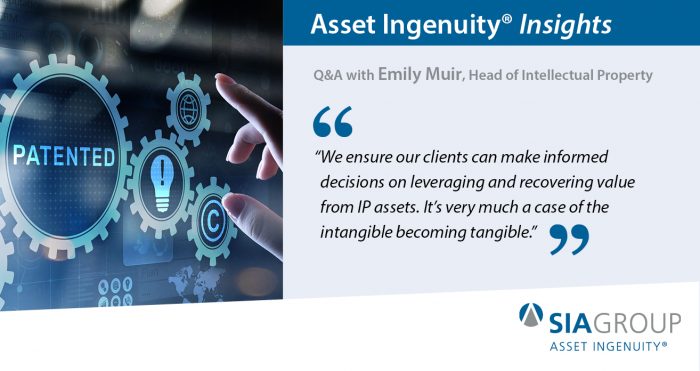Q&A with Emily Muir, Head of Intellectual Property, SIA Group
Making the Intangible Tangible
Welcome to the second edition of our Asset Ingenuity® Insights Q&A series, where we explore the world of intellectual property valuations and its importance for asset-based lenders, turnaround, restructuring and insolvency professionals. Our featured guest, Emily Muir, Head of Intellectual Property at SIA Group is an expert in her field. Having joined the company in October 2022, Emily shares her insights on the increasing significance of intellectual property and its growing role in today’s changing business landscape.
Q: What drew you to SIA Group?
A: I’ve spent the last ten years of my career working in insolvency, which has given me a lot of valuable experience dealing with cases of different sizes. I teamed up with my father to start a business advisory practice and then an opportunity came up at a specialist intellectual property firm where I managed intellectual property valuations and disposals in distress scenarios. I had previously worked with SIA Group for two years as an outsourced partner, so I was already familiar with the team; and I have to say, I was impressed by their business approach, the personalities involved and their culture. They have a superb base of partners and clients and have built strong relationships along the way. So, when we started discussing the idea of formalising a new service offering in respect of Intellectual Property valuations, I was thrilled to come on board with SIA Group. After learning more about their business model, operations, and vision it seemed the perfect opportunity.
Q: Is this where we get into the dark arts?
A: It’s quite common to hear people say that valuing Intellectual Property is a proprietary process shrouded in mystery. However, here at SIA Group, we are keen to dispel this notion and demystify the process. Transparency is at the core of our business, and we believe that our clients deserve to know how we arrive at our intellectual property valuations. Rather than being unnecessarily technical and overly complicated, we make a point of clearly explaining the methodologies we use and why we use them, as well as the steps we take to arrive at a valuation. So, whether we’re looking at a distressed situation or a lending transaction, our primary objective is always the same, to instil greater confidence through accurate, credible, and reliable valuations.
Q: What typical IP valuation scenarios do you see in the restructuring sector?
A: An Insolvency Practitioner could contact us for valuation services for statutory purposes because their client is thinking about entering administration or a CVA. There are a few reasons why they might need to take a closer look at the client’s intellectual property. It could be because the client provided information about their IP assets, or the insolvency practitioner did some research. In some cases, the client may have limited physical assets but a decent revenue and the insolvency practitioner may identify that the key to their business likely lies in the intangible assets.
Q: How does Intellectual Property appraisal benefit the ABL industry in your view?
A: With all the changes happening in the security landscape around Crown Preference, we’re seeing a big opportunity to work closely with banks and asset-based lenders on providing valuations for intellectual property assets. These valuations are already seen as critical in insolvency and restructuring scenarios, but we anticipate an increase in formal workstreams as asset based lenders (“ABL”) start securing, leveraging and recovering value against brand and other important IP assets. What lenders want is a worst-case scenario on asset valuations to support lending on both new deals to maximise funding availability and audit/reviews of portfolio businesses to protect their loans and add further value if appropriate.
ABLs must prioritise securing their position to protect themselves in the event of potential client insolvency. This can be achieved by taking appropriate fixed charge security over valuable intellectual property. Additionally, lending over IP can be a way for ABLs to maximise value and support for businesses.
We might suggest taking a security interest over specific IP assets that don’t currently have a fixed charge on them. If that’s the case, the next step would be to register any fixed charge over those relevant IP assets with Companies House. We make sure that we have captured all relevant IP assets, whether these are brand-related, databases, organisational knowledge, critical processes, trade secrets, designs, patents and software.
Q: What are the effective methodologies for valuing an intangible asset?
A: Intangible assets can be valued using the same rigorous methods as physical assets, using one of the three primary valuation approaches; market-based, income-based and cost-based. Physical assets such as machinery, equipment and property are predominantly valued using market-based methods by comparing them to similar sales. Due to the specialised nature of intangible assets, that isn’t always possible for IP valuations.
When it comes to comparing intangible assets there are a range of factors that need to be taken into consideration, such as quality, security, protection and profitability. It’s important to add that intangible assets should never be valued in isolation. They need to be valued in context of the value drivers and the mechanics of the wider business. There’s no substitute for asking the right questions and gaining a comprehensive understanding of the company’s business model.
Q: When it comes to brand valuation, what factors do you take into consideration?
A: Valuing a brand ultimately involves a judgment based on its quality. That means analysing marketing spend in relation to revenue, customer loyalty, and relationships with customers. If a business has a lot of behavioural data on its customers, it’s inherently more valuable than a business that only knows its customers’ first names. Also, we recognise the nuances within different industries and sectors and take these into account when we value a brand’s worth.
Q: How do you ensure the accuracy of valuations for intangible assets?
A: Some people might think that the only way to determine the value of IP assets is through a sale. But actually, most of the work we do is front-end focused, advising clients before an event happens. To ensure that our valuations are accurate, we take a robust approach by selecting an appropriate methodology and cross-checking it with one or two others to compare the results. Our methodologies are aligned with the standards set by the International Valuation Standards Council (IVSC), endorsed by The Royal Institution of Chartered Surveyors (RICS) Red Book. By adhering to these standards and applying the business and intangible asset valuation methodologies correctly, we can provide our clients with dependable valuations they can trust and that they are confident will stand up to scrutiny and realise value to creditors when required.
Ultimately, our aim is to provide accurate and well researched intellectual property valuation and disposal advice. In this way, we ensure our clients can make informed decisions on leveraging and recovering value from IP assets. It’s very much a case of the intangible becoming tangible.
In conclusion, we would like to extend our gratitude to Emily Muir for sharing her valuable insights on Intellectual Property valuation. Having an in depth understanding of IP valuation is crucial for asset-based lenders, insolvency practitioners and restructuring professionals. Stay tuned for more expert thoughts in our next edition of Asset Ingenuity® Insights.







 are registered trademarks of SIA Group Asset Ingenuity Limited
are registered trademarks of SIA Group Asset Ingenuity Limited